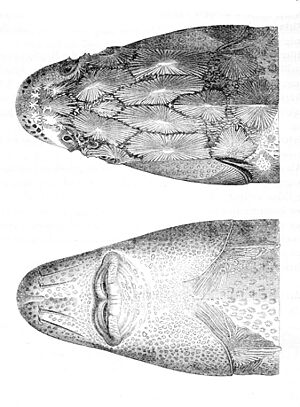Russian sturgeon facts for kids
Quick facts for kids Russian sturgeon |
|
|---|---|
 |
|
 |
|
| Conservation status | |
| Scientific classification | |
| Genus: |
Acipenser
|
| Species: |
gueldenstaedtii
|
| Synonyms | |
|
|
The Russian sturgeon (Acipenser gueldenstaedtii) is a type of fish in the Acipenseridae family. It is also known as the diamond sturgeon or Danube sturgeon. You can find this fish in many countries. These include Azerbaijan, Bulgaria, Georgia, Iran, Kazakhstan, Romania, Russia, Turkey, Turkmenistan, and Ukraine. It also lives in the Caspian Sea.
This fish can grow very large. It can reach about 235 centimeters (over 7 feet) long. It can also weigh up to 115 kilograms (about 250 pounds). Russian sturgeons grow and reproduce slowly. This makes them very easy to overfish. You can tell them apart from other sturgeon species. They have a short snout with a rounded tip. Their lower lip is also broken in the middle.
Contents
What the Russian Sturgeon Looks Like
The Russian sturgeon can grow up to 210 centimeters (about 7 feet) long. But most of them are usually between 110 and 140 centimeters (about 3.5 to 4.5 feet) long. It has a fairly short and rounded snout. It also has three pairs of barbels. These are like whiskers and are closer to the tip of its snout than to its mouth.
The fish has a dorsal fin with 27 to 48 soft rays. Its anal fin has 16 to 35 rays. The number of scales along its lateral line can be from 21 to 50. You can tell this fish apart from the similar starry sturgeon. Look at the shape of its snout, its barbels, and how its scales are arranged. The top of the Russian sturgeon is grayish-green. Its side scales are pale, and its belly is white.
Where They Live and Their Home
The Russian sturgeon is originally from the Black Sea, the Sea of Azov, and the Caspian Sea. It is an anadromous fish. This means it lives in saltwater but travels to freshwater rivers to lay its eggs. It moves into the river systems that flow into these seas. It goes upstream to find places to spawn (lay eggs).
This fish usually lives near the bottom of the water. It prefers fairly shallow areas. It likes places with sandy or muddy bottoms.
What They Eat and How They Live
The Russian sturgeon eats different kinds of food. It feeds on crustaceans, which are like tiny crabs. It also eats molluscs, such as snails or clams. Small fish are also part of its diet. These include gobies, anchovies, and sprats.
When it is in the sea, the Russian sturgeon usually lives alone. But when it moves upriver to spawn, it becomes more social. This happens in April, May, and June.
Amazing Hybrid Fish
In 2020, scientists did something amazing. They took eggs from three Russian sturgeons. They then crossbred them with American paddlefish. This created successful hybrid fish called sturddlefish.
These new hybrid fish had a good survival rate, between 62% and 74%. On average, they grew to about 1 kilogram (2.2 pounds) after just one year. This was the first time that fish from such different groups (different genera and families) successfully crossbred.
See also



